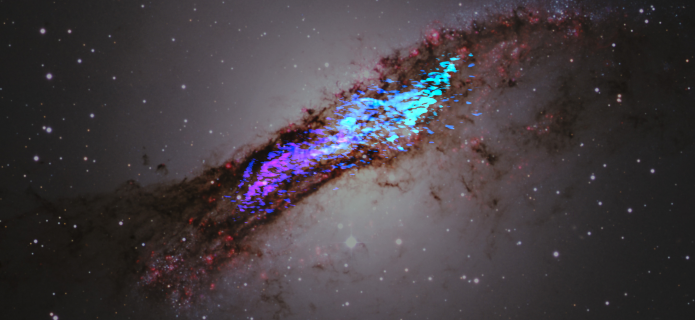ALMA Turns its Eyes to Centaurus A
A new image of the center of the distinctive galaxy Centaurus A, made with the Atacama Large Millimeter/submillimeter Array (ALMA), shows how the new observatory allows astronomers to see through the opaque dust lanes that obscure the galaxy’s center, with unprecedented quality. ALMA is currently in its Early Science phase of observations and is still under construction, but is already the most powerful telescope of its kind in the world. The observatory has just issued the Call for Proposals for its next cycle of observations, in which the growing telescope will have increased capabilities.
Centaurus A [1] is a massive elliptical radio galaxy — a galaxy which emits strong radio waves — and is the most prominent, as well as by far the nearest, radio galaxy in the sky [2]. Centaurus A has therefore been observed with many different telescopes. Its very luminous centre hosts a supermassive black hole with a mass of about 100 million times that of the Sun.
In visible light, a characteristic feature of the galaxy is the dark band that obscures its center. This dust lane harbors large amounts of gas, dust and young stars. These features, together with the strong radio emission, are evidence that Centaurus A is the result of a collision between a giant elliptical galaxy, and a smaller spiral galaxy whose remains form the dusty band.
To see through the obscuring dust in the central band, astronomers need to observe using longer wavelengths of light, such as infrared light or radio waves. For years astronomers have yearned to study the gas within the galaxy but it has been obscured by the dust lane
The new ALMA observations, shown in a gradation of blue in this image, reveal the position and motion of the clouds of gas in the galaxy. They are the sharpest and most sensitive such observations ever made. ALMA was tuned to detect signals with a wavelength around 1.3 millimeters, emitted by molecules of carbon monoxide gas. The motion of the gas in the galaxy causes slight changes to this wavelength, due to the Doppler effect [3]. The motion is shown in this image as changes in color. Violet and dark-blue features trace gas coming towards us while light-blue features depict gas moving away. We can see that the gas to the left of the center is moving towards us, while the gas to the right of the center is moving away from us, indicating that the gas is orbiting around the galaxy.
The ALMA observations are overlaid on an optical image of Centaurus A produced by the Wide Field Imager (WFI) of the MPG/ESO 2.2-meter telescope at ESO’s La Silla Observatory in Chile, with a total exposure time of more than 50 hours. It allows to appreciate the galaxy’s elliptical nature, which shows up as the elongated shape of the fainter outer parts. The glow that fills much of the optical layer comes from hundreds of billions of cooler and older stars. Unlike most elliptical galaxies, however, Centaurus A’s smooth shape is disturbed by a broad and patchy band of dark material that obscures the galaxy’s center, such part which is perfectly visible thanks to the eyes of ALMA. This is an example of how observations with ALMA can complement those from other telescopes.
In parallel, ALMA has recently published a new call to the astronomical community to present proposals for observation, this time for Cycle 1 of its Early Science phase. These observations will take place between January and October 2013 and will use about twice the number of antennas available in Cycle 0, that is, 32 antennas, each twelve meters in diameter. In addition, Cycle 1 will provide a number of new capabilities and will feature the launch of the Atacama Compact Array (ACA) to improve observations of larger structures. Although not yet complete, the ACA will have 9 antennas with a diameter of seven meters and 2 antennas with a diameter of twelve meters during Cycle 1.
Construction of ALMA, on the Chajnantor Plateau in northern Chile, will be completed in 2013, when 66 high-precision antennas will be fully operational. Half of the antennas are already installed. Early scientific observations with a partial array began in 2011, and are already producing outstanding results. The ALMA observations of Centaurus A shown here were taken as part of the Commissioning and Science Verification phase of the telescope.
The Atacama Large Millimeter/submillimeter Array (ALMA), an international astronomy facility, is a partnership of Europe, North America and East Asia in cooperation with the Republic of Chile.
Notes
[1] This galaxy is called Centaurus A because it was the first major source of radio waves discovered in the constellation of Centaurus, in the 1950s. It is also referred as NGC 5128. The galaxy was discovered by British astronomer James Dunlop on August 4, 1826.
[2] Centaurus A lies about 12 million light-years away in the southern constellation of Centaurus (The Centaur).
[3] The Doppler effect is the change in wavelength of a wave for an observer moving relative to the source of the wave. Molecules in gas clouds in space emit light at well-defined wavelengths, and so the motion of these clouds leads to slight changes in the wavelengths that are detected.
Contact
Valeria Foncea
Education and Public Outreach Deputy Officer
Tel: +56 2 467 6258
